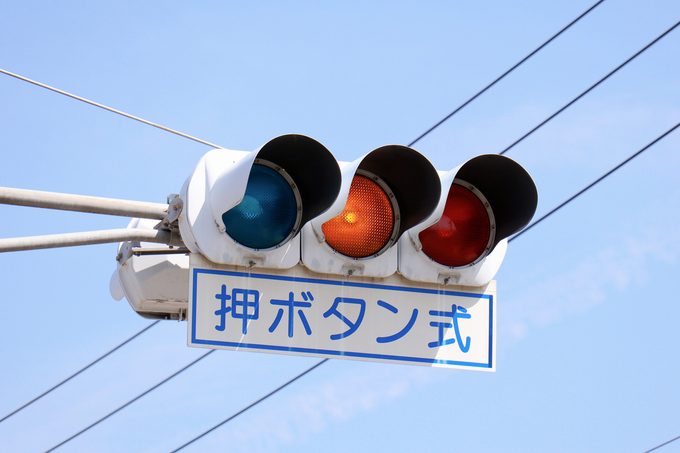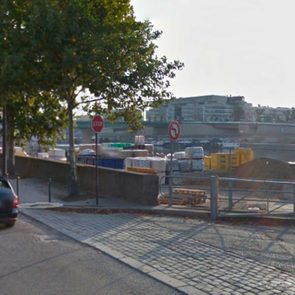This is what happens when you have one word for two different colors

This Is Why Japan Has “Blue” Traffic Lights Instead of Green

Before we’re old enough to even see over the dashboard, we learn that green means go and red means stop. This internationally recognized traffic light color system is standard in most of the world. But if you’ve traveled around Japan (like I have), you’ve likely noticed that some traffic lights look a bit more blue than green—and even the decidedly green ones are described as ao (blue) rather than midori (green) in Japanese.
So why are traffic lights considered blue in Japan? Ahead, Makiko Yamagata, a native Japanese speaker who lives in Nagoya, Japan, and Katsuhiro Ito, also a native Japanese speaker as well as a language and culture expert, explain the history and nuances behind Japan’s “blue” traffic lights.
Get Reader’s Digest’s Read Up newsletter for more news, humor, travel, tech and fun facts all week long.
Why are traffic lights “blue” in Japan?
Insight into the Japanese language and history can help explain why green traffic lights in Japan are called blue. “In ancient Japanese, only four color names existed: red, black, white and blue,” says Ito, a Japanese language teacher for more than 20 years. “The term ao was used to refer to a broad range of colors, including what we now call green.” Back in those days, if you wanted to describe something green, you’d use the word for “blue.” That system stuck until the Heian Period (794-1185) when the word midori (representing the color of nature and greenery as well as vitality) started showing up to describe what we now know as green.
Ito says an initially limited number of color terms was not unique to the ancient Japanese language—it was true of many languages in the past. And despite the eventual evolution of language and the addition of other color descriptors, the ancient influence can still be seen in modern-day conversations. “As a remnant of that, even today,” Ito says, “green things are sometimes still referred to as ‘ao.'” (More on those below.)
While this often perplexes foreigners and language learners, it’s perfectly normal for native Japanese. “It’s so natural for us to call certain green things blue,” says Yamagata. In fact, it’s so ingrained that she says she only noticed the traffic light color confusion after her foreign friends asked about it.
While “go” signals in Japan are generally green or a shade of blue-green, and the ancient days of identifying colors by just four categories are far behind us, Yamagata says there’s no stop sign in sight when it comes to using ao to describe green traffic lights. “I still call them blue, and tell my kids they’re blue. So they will probably keep going as blue!”
What’s the history of Japan’s blue traffic lights?

Japan’s traffic signal colors are historically similar to those around the world—red for stop, yellow for caution and green for go. But linguistically, the green light in Japan has long been called ao shingou (blue signal), and in some places, it does appear more blue than green.
The global standard of a green light indicating “go” was set by the Vienna Convention on Road Signs and Signals Treaty in 1968. Some countries, like the U.S. and Japan, never signed the agreement, so it is possible to find variations of the standard red, yellow and green traffic lights.
“When traffic signals were first introduced to Japan [in the 1930s], the green light was sometimes called green, just like in other countries,” Ito explains. “However, after World War II, the Road Traffic Act [of 1960] described the traffic light as ‘ao,’ and it has been referred to that way ever since.”
But the move was not without controversy. Some linguists took issue with continuing to call green-colored lights blue, and global traffic standards established the expectation that the lights should indeed be green. Meanwhile, Japanese citizens were accustomed to referring to them as blue. There was a clash of Japanese linguistic heritage and habit with international standards and modern language. In 1973, the Japanese government attempted to put the issue to rest. A cabinet order required traffic lights to be a blue shade of green—green enough to appease concerns about international traffic customs, yet blue enough to still be called “ao.” The mandate seemed to solve the issue on paper, but it continues to confuse travelers and non-native speakers in Japan.
What else might be called blue that’s really green?
Traffic lights aren’t the only visually green thing referred to as blue in Japanese. Many other words and phrases include ao, such as aona (green leafy vegetables). Here are some other examples Ito and Yamagata shared of some visually green things with blue descriptions in Japanese:
- aoringo: green apple
- aotake: young bamboo
- aota: a rice field where the green rice plants have not yet ripened
- aonori: a visually green type of seaweed sprinkled on some hot Japanese dishes, such as okonomoyaki (a savory pancake)
Ao can also convey that something is young or new, Yamagata explains, “so things described as ‘ao’ are not necessarily visually blue.” Aoba, for example, literally translates to “blue leaves,” yet the term is used for young green leaves, Ito says. “And fresh appearances are described as ‘aoi’ or ‘aoaoshii’ (fresh or greenish).”
Ito explains that these examples show how the word has developed different semantic branches. “For instance, since ao refers to the color of young leaves, it is also metaphorically used to mean immature or inexperienced.” In Japanese, you can say “kare wa mada aoi” to mean “he is still inexperienced.” Notice that the “ao” at the end of the sentence technically means blue, yet it is understood in the same way we say someone is “green” in English to express that they’re young or inexperienced!
Ito says you can also find expressions in Japanese, such as “tonari no shiba wa aoi” (which means “the grass is always greener on the other side”), where “green” is understood but the word for “blue” is actually used.
So, are traffic lights in Japan actually blue?
Traffic lights are “ao” (blue) linguistically in Japanese, but not really visually. Although you can see traffic lights in Japan with a blue-ish hue rather than the typical green you might find in other countries, they are generally understood to be visually green but referred to as blue in the Japanese language. If Japan is on your travel list and you find yourself in a car with native Japanese speakers, remember: Ao—not green—means go!
About the experts
|
Why trust us
At Reader’s Digest, we’re committed to producing high-quality content by writers with expertise and experience in their field in consultation with relevant, qualified experts. We rely on reputable primary sources, including government and professional organizations and academic institutions as well as our writers’ personal experiences where appropriate. We verify all facts and data, back them with credible sourcing and revisit them over time to ensure they remain accurate and up to date. Read more about our team, our contributors and our editorial policies.
Sources:
- Makiko Yamagata, native Japanese speaker; email interview, May 2025
- Katsuhiro Ito, native Japanese speaker and language teacher; email interview, May 2025
- Tenyomi: “Green”
- United Nations Treaty Collection: “Convention on Road Signs and Signals”
- Japanese Law Translation: “Road Traffic Act”
- JapanUp!: “Why are traffic lights blue in Japan?”























